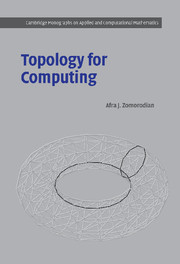2 - Spaces and Filtrations
Published online by Cambridge University Press: 19 August 2009
Summary
In this chapter, we describe the input to all of the algorithms described in this book, and the process by which such input is generated. We begin by formalizing the kind of spaces that we are interested in exploring. Then, we introduce the primary approach used for computing topology: growing a space incrementally and analyzing the history of its growth. Naturally, the knowledge we derive from this approach is only as meaningful as the growth process. So, we let the geometry of our space dictate the growth model. In this fashion, we encode geometry into an otherwise topological history. The geometry of our space controls the placement of topological events within this history and, consequently, the life-span of topological attributes. The main assumption of this method is that longevity is equivalent to significance. This approach of exploring the relationship between geometry and topology is not new. It is the hallmark of Morse theory (Milnor, 1963), which we will study in more detail in Chapter 5.
The rest of the chapter describes the process outlined in Figure 2.1. We begin with a formal description of topological spaces. We then describe two types of such spaces, manifolds and simplicial complexes, in the next two sections.
- Type
- Chapter
- Information
- Topology for Computing , pp. 13 - 40Publisher: Cambridge University PressPrint publication year: 2005



